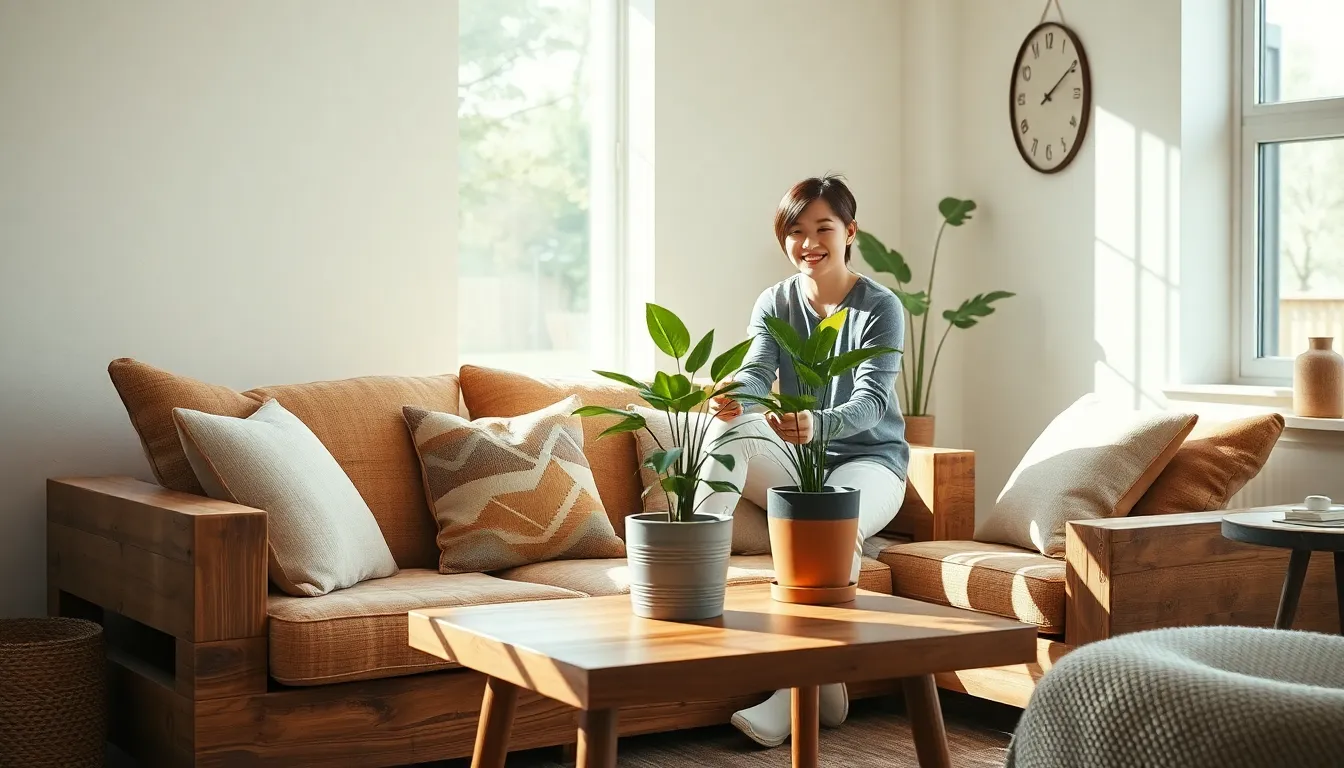In a world increasingly aware of environmental issues, sustainable furniture is gaining traction as a smart choice for conscious consumers. This innovative approach not only prioritizes eco-friendly materials but also embraces ethical production practices, making it a compelling option for those looking to furnish their homes responsibly.
Sustainable furniture blends style with purpose, offering designs that are as aesthetically pleasing as they are environmentally friendly. By choosing pieces crafted from reclaimed wood, recycled materials, or sustainably sourced resources, individuals can make a significant impact on reducing waste and preserving natural habitats. As the trend toward sustainability continues to grow, understanding the benefits of sustainable furniture becomes essential for anyone looking to create a beautiful and responsible living space.
Table of Contents
ToggleUnderstanding Sustainable Furniture
Sustainable furniture embodies environmentally friendly materials and responsible production methods. It plays a crucial role in fostering a harmonious relationship between aesthetic appeal and ecological mindfulness.
Definition of Sustainable Furniture
Sustainable furniture refers to items crafted from eco-friendly materials and produced through ethical processes. This furniture utilizes resources like reclaimed wood, recycled metals, and natural fibers. The design and manufacturing protocols prioritize minimal environmental impact, ensuring longevity and durability.
Importance of Sustainability in Furniture
- Environmental Protection: Sustainable furniture reduces waste and pollution by utilizing renewable resources and minimizing harmful chemicals.
- Conservation of Resources: It conserves natural resources through the recycling of materials or the use of sustainably harvested products.
- Health Benefits: Eco-friendly furniture often contains fewer toxic substances, promoting healthier indoor air quality and overall well-being.
- Economic Value: Investing in sustainable furniture can yield long-term savings due to its durability and low maintenance requirements.
- Ethical Practices: These products often come from manufacturers committed to ethical labor practices, ensuring fair wages and safe working conditions.
- Aesthetic Appeal: Sustainable furniture combines style with environmental responsibility, offering unique designs that enhance contemporary living spaces.
Types of Sustainable Furniture

Sustainable furniture comes in various types, each offering unique materials and benefits. The following categories highlight some of the most popular options.
Reclaimed Wood Furniture
Reclaimed wood furniture comprises items crafted from salvaged timber. This approach reduces deforestation by repurposing wood that may otherwise go to waste. Reclaimed wood often features distinct character and history, enhancing aesthetic appeal. It provides durability and resilience, making it a valuable addition to any space. Common sources include old buildings and barns.
Bamboo Furniture
Bamboo furniture utilizes bamboo, a fast-growing grass known for its strength and sustainability. Bamboo can reach maturity in three to five years, making it a renewable resource. It’s lightweight, sturdy, and versatile, suitable for various furniture styles. Bamboo furniture often boasts a modern, sleek look while contributing to eco-friendliness by minimizing deforestation.
Upcycled Furniture
Upcycled furniture involves transforming existing items into new, functional pieces. This process minimizes waste by diverting unwanted furniture from landfills. Upcycled items may incorporate various materials, such as fabrics and industrial components. Creativity flourishes in upcycling, resulting in one-of-a-kind pieces that often reflect artistic flair. This approach also emphasizes the importance of resourcefulness in sustainable living.
Benefits of Sustainable Furniture
Sustainable furniture offers a multitude of advantages that extend across environmental, health, and economic dimensions. Choosing sustainable options contributes to a healthier planet and enhances personal well-being.
Environmental Impact
Sustainable furniture significantly reduces environmental harm by using eco-friendly materials. By utilizing reclaimed wood, recycled metals, or sustainably sourced fibers, these products minimize deforestation and waste. For instance, opting for reclaimed wood furniture helps eliminate the need for harvesting new trees, preserving natural habitats. Sustainable production processes also lower carbon emissions, reducing pollution levels and conserving essential resources. Choosing sustainably produced furniture enables consumers to actively participate in environmental protection.
Health Benefits
Sustainable furniture promotes healthier living spaces by minimizing exposure to toxic substances. Many conventional furniture items contain harmful chemicals, such as formaldehyde or volatile organic compounds (VOCs), that can cause respiratory issues and other health concerns. Sustainable alternatives often utilize natural finishes and adhesives, enhancing indoor air quality. Consumers benefit from reduced allergens and improved well-being. By selecting sustainable furniture, individuals create safer and more comfortable environments in their homes.
Economic Advantages
Investing in sustainable furniture often leads to long-term savings. High-quality, durable materials ensure longevity, reducing the need for frequent replacements. Additionally, sustainable furniture typically requires less maintenance than conventional items, saving time and money on repairs. Supporting eco-conscious manufacturers fosters a fair economic model, where ethical practices prioritize fair labor conditions. By selecting sustainable options, consumers make financially sound investments that align with their values, contributing to a more sustainable economy.
Choosing Sustainable Furniture
Choosing sustainable furniture involves considering various features and certifications that ensure eco-friendliness and ethical production. Sustainable options enhance living spaces while contributing to environmental preservation.
Key Features to Look For
- Materials: Prioritize furniture made from reclaimed wood, recycled metals, or natural fibers. These materials minimize resource depletion and waste.
- Durability: Select items built to last, reducing the frequency of replacements. High-quality sustainable furniture often withstands wear and tear better than conventional options.
- Non-toxic finishes: Look for finishes that contain low or no volatile organic compounds (VOCs). Non-toxic options improve indoor air quality and promote healthier living environments.
- Local production: Seek furniture produced locally to reduce transportation emissions. Supporting local artisans often enhances community economies.
- Design versatility: Opt for timeless designs that adapt to changing decors. Versatile pieces ensure long-term usability without trendy obsolescence.
Certifications and Labels
- FSC Certification: Verify that wood products bear the Forest Stewardship Council (FSC) label. This ensures responsible sourcing and promotes sustainable forestry practices.
- Global Organic Textile Standard (GOTS): Look for textiles with GOTS certification, which guarantees the use of organic materials and ethical production processes.
- GREENGUARD Certification: Identify items with GREENGUARD certification for assurance of low chemical emissions, promoting safer indoor air quality.
- Cradle to Cradle Certified: Seek furniture with the Cradle to Cradle certification, indicating that products are designed for their entire lifecycle and can be fully recycled or upcycled.
- Energy Star Label: Furniture that incorporates energy-efficient components may display the Energy Star label, showcasing their commitment to reducing environmental impact.
By focusing on these key features and certifications, individuals can make informed choices that align with environmental sustainability and ethical practices.
Sustainable furniture represents a significant shift towards responsible living. By prioritizing eco-friendly materials and ethical production practices, consumers can make choices that benefit both their homes and the planet. This approach not only enhances the aesthetic appeal of living spaces but also promotes health and well-being through reduced exposure to harmful substances.
Investing in sustainable furniture is a step toward a more sustainable future. It allows individuals to express their style while supporting ethical manufacturing and conservation efforts. With a variety of options available, everyone can find pieces that resonate with their values and contribute to a healthier environment. Embracing sustainable furniture is more than just a trend; it’s a commitment to a better world for generations to come.




